Army of the Duchy of Warsaw
Army of the Duchy of Warsaw refers to the military forces of the Duchy of Warsaw. The Army was significantly based on the Polish Legions; it numbered about 30,000 and was expanded during wartime to almost 100,000. It was composed of infantry with a strong cavalry force supported by artillery. The Napoleonic customs and traditions resulted in some social tensions, but are generally credited with helpful modernization and useful reforms.
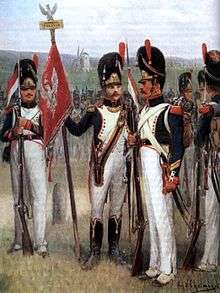
Size
The cadre of the Army of the Duchy of Warsaw was formed by the legionnaires of the Polish Legions.[1][2] In addition, it was filled by older soldiers from the Army of the Polish–Lithuanian Commonwealth, who responded to the call to arms of Józef Poniatowski, and patriotic youth.[3] In 1808, after the first emergency period was over, and the Duchy felt more secure, those who wished to leave the army were given leave.[3] The army was expanded with large waves of new recruits on the eve of new wars in 1809 and 1812, when the Duchy fought other partitioners, which resulted in an influx of recruits from those territories, hoping to see their home liberated.[3] The final recruitment phase was that in the fall and winter of 1813, when the Duchy was trying to rally to its own defense in the aftermath of Napoleon's defeat in Russia.[3]
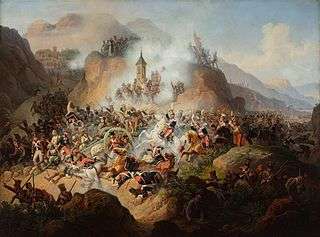
Upon its creation, the Army numbered 30,000 (out of the Duchy's population of 2.6m).[4][5] The size of the army was a considerable economic burden to the small state.[5] The army was expanded several times; it was doubled in 1809.[5] Several regiments were sponsored by the French.[5] For the war of 1812, almost 100,000 men were fielded – more than the Army of the Polish–Lithuanian Commonwealth ever numbered.[6] In the fall of 1813, the Army, reconstructed after the defeat in Russia, numbered about 20,000[3] or 40,000[7] (sources vary).
It is estimated that about 180,000 to 200,000 men served in the Army throughout its brief existence.[5]
In addition to the Army of the Duchy of Warsaw, Poles also served in other formations allied to France; most notably, the Vistula Legion.[8] In addition to the standing army, a national guard could be called into action, as happened in 1809 and 1811.[8]
Notable Polish commanders of the Army of the Duchy of Warsaw included Prince Józef Poniatowski (who was the army chief commander throughout most of its history)[9] and Jan Henryk Dąbrowski.[8]
Composition
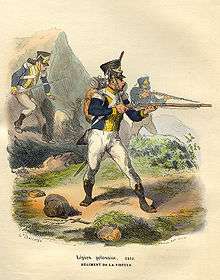
The Army of the Duchy of Warsaw was composed of the following formations:
- one regiment of cuirassiers (14th)[10]
- ten regiments of uhlan lancers (2nd, 3rd, 6th, 7th, 8th, 9th, 11th, 12th, 15th, 16th); five more were formed in Lithuania in 1812[11]
- two regiments of hussars (10th and 13th)[12]
- three regiments of chasseurs (1st, 4th and 5th)[13]
- seventeen regiments of infantry (numbered one through seventeen; five more were formed in Lithuania in 1812)[14]
- one regiment of horse artillery (composed of four companies)[15]
- twenty five companies of regular artillery[16]
In 1813 several units of light cavalry, the Krakusi (Cracus, or Polish cossacks), were planned; in the end, one regiment was formed.[17][18]
Culture, training and time of service
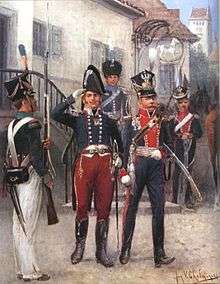
The Army was the site of a cultural clash of new, democratic French traditions and old Polish customs, with clashes on the role of nobility in the military – with some conservatives attempting to restrict the officer rank to the nobles.[8] The French revolutionary and civic traditions, passed through veteran legionnaires, resulted in more motivation of the peasant recruits, compared to the army of the old Commonwealth.[3][19] The educational role of the army is seen as one of its major if unintended successes.[19] The army was also improved due to the modernization and adoption of modern French military rules and tactics.[19] Overall, the era of the Duchy of Warsaw marked a period of modernization of the Polish Army, with a new military doctrine and science that was codified by Polish military scholar of that era, Ignacy Prądzyński.[8]
The obligatory time of service was set at 6 years, with any citizens aged 21 to 28 having a chance to be randomly chosen for conscription.[8] The Army was supported by the new schools, with the 3-year Elementary School and a 1-year Applicant School for Artillery and Engineering.[8]
Overall, the Polish units were reckoned by the French to be highly motivated and of high quality.[5]
Operational history
The army was formed at the time of the creation of the Duchy of Warsaw in 1807. The army participated in numerous wars on the side of Napoleonic France, including in the War of the Fourth Coalition (1806–1807), Peninsular War, the War of the Fifth Coalition (primarily in the Polish–Austrian War) of 1809, and in the War of the Sixth Coalition (in particular, in the French invasion of Russia) of 1812–1813.[8] In the Russian campaign of 1812, the Polish units formed an entire corps (the V Corps) of the Grande Armée.[20] The army sustained over 70% losses.[7] The Army suffered further heavy casualties in the battle of Leipzig in 1813, where Prince Poniatowski died.[21][22]
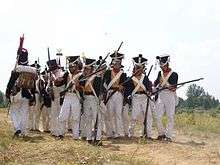
After Napoleonic defeats in 1813, the Duchy was occupied by Napoleon's enemies.[18][21][23] As several garrisons in fortresses held out, much of the Army followed Napoleon back to France that year.[18][23] Disorganized after Poniatowski's death, in 1814, the army still had about 8,000 people in French-controlled territories, mostly in France, but was incorporated into the French Army, and ceased to exist after the final defeat of Napoleon.[18][21][23] After the Treaty of Fontainebleau most of the Polish soldiers were given into the custody of the Russians.[24]
See also
- Army of the Congress Poland
- Military of the Polish–Lithuanian Commonwealth
- Polish Armed Forces
References
- Piotr Stefan Wandycz (1980). The United States and Poland. Harvard University Press. p. 53. ISBN 978-0-674-92685-1. Retrieved 10 May 2012.
- Paul Robert Magocsi; Jean W. Sedlar; Robert A. Kann; Charles Jevich; Joseph Rothschild (1974). A History of East Central Europe. University of Washington Press. p. 29. ISBN 978-0-295-95358-8. Retrieved 10 May 2012.
- "Wojsko polskie". Napoleon.org.pl. Archived from the original on 2012-05-14. Retrieved 2012-05-11.
- Jacek Jędruch (1998). Constitutions, elections, and legislatures of Poland, 1493–1977: a guide to their history. EJJ Books. p. 206. ISBN 978-0-7818-0637-4. Retrieved 13 August 2011.
- Paul Robert Magocsi; Jean W. Sedlar; Robert A. Kann; Charles Jevich; Joseph Rothschild (1974). A History of East Central Europe. University of Washington Press. p. 48. ISBN 978-0-295-95358-8. Retrieved 11 May 2012.
- William Fiddian Reddaway (1971). The Cambridge History of Poland. CUP Archive. p. 232. GGKEY:2G7C1LPZ3RN. Retrieved 11 May 2012.
- William Fiddian Reddaway (1971). The Cambridge History of Poland. CUP Archive. p. 233. GGKEY:2G7C1LPZ3RN. Retrieved 11 May 2012.
- Juliusz Bardach, Boguslaw Lesnodorski, and Michal Pietrzak, Historia panstwa i prawa polskiego (Warsaw: Paristwowe Wydawnictwo Naukowe), 1987, p.356-357
- Norman Davies (23 August 2001). Heart of Europe: The Past in Poland's Present. Oxford University Press. p. 162. ISBN 978-0-19-280126-5. Retrieved 11 May 2012.
- "Kirasjerzy". Napoleon.org.pl. Archived from the original on 2012-03-06. Retrieved 2012-05-11.
- "Ułani". Napoleon.org.pl. Archived from the original on 2011-09-17. Retrieved 2012-05-11.
- "Huzarzy". Napoleon.org.pl. Archived from the original on 2013-04-04. Retrieved 2012-05-11.
- "Szaserzy". Napoleon.org.pl. Archived from the original on 2013-04-04. Retrieved 2012-05-11.
- "Piechota". Napoleon.org.pl. Archived from the original on 2013-04-04. Retrieved 2012-05-11.
- "Artyleria konna". Napoleon.org.pl. Archived from the original on 2013-04-04. Retrieved 2012-05-11.
- "Artyleria piechoty". Napoleon.org.pl. Archived from the original on 2013-04-04. Retrieved 2012-05-11.
- "Napoleon.org.pl". Napoleon.org.pl. Archived from the original on 2012-03-06. Retrieved 2012-05-11.
- John R. Elting (22 March 1997). Swords Around A Throne. Da Capo Press. pp. 380–3812. ISBN 978-0-306-80757-2. Retrieved 11 May 2012.
- William Fiddian Reddaway (1971). The Cambridge History of Poland. CUP Archive. pp. 229–. GGKEY:2G7C1LPZ3RN. Retrieved 11 May 2012.
- Otto Pivka (20 March 2012). Napoleon's Polish Troops. Osprey Publishing. p. 19. ISBN 978-1-78096-549-9. Retrieved 11 May 2012.
- Norman Davies (1982). God's Playground, a History of Poland: 1795 to the present. Columbia University Press. p. 269. ISBN 978-0-231-05353-2. Retrieved 10 May 2012.
- Ronald Pawly; Patrice Courcelle (21 August 2007). Napoleon's Polish Lancers of the Imperial Guard. Osprey Publishing. p. 4. ISBN 978-1-84603-256-1. Retrieved 11 May 2012.
- Otto Pivka (20 March 2012). Napoleon's Polish Troops. Osprey Publishing. pp. 22–23. ISBN 978-1-78096-549-9. Retrieved 11 May 2012.
- David Laven; Lucy Riall (1 February 2000). Napoleon's Legacy: Problems of Government in Restoration Europe. Berg. p. 116. ISBN 978-1-85973-249-6. Retrieved 11 May 2012.
| Wikimedia Commons has media related to Army of the Duchy of Warsaw. |